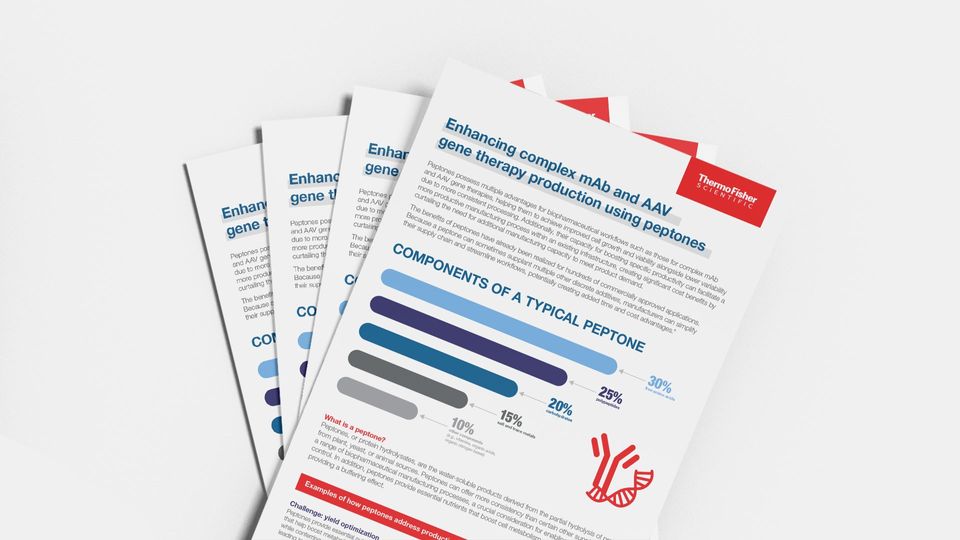The biopharmaceutical industry faces mounting pressure to produce complex monoclonal antibodies (mAbs) and adeno-associated virus (AAV) gene therapies more efficiently while maintaining stringent quality standards.
Download this infographic to discover how incorporating peptones into your workflow can revolutionize your biopharmaceutical manufacturing processes.
Discover:
- Improved cell growth and viability, leading to more efficient and productive biopharmaceutical manufacturing processes.
- Reduced variability in production, ensuring higher quality and reproducibility.
- Cost-effective production, reducing the need for additional manufacturing capacity, thus lowering overall production expenses.
Enhancing complex mAb and AAV
gene therapy production using peptones
What is a peptone?
Peptones, or protein hydrolysates, are the water-soluble products derived from the partial hydrolysis of proteins
from plant, yeast, or animal sources. Peptones can o�er more consistency than certain other supplements for
a range of biopharmaceutical manufacturing processes, a crucial consideration for enabling reproducibility and
control. In addition, peptones provide essential nutrients that boost cell metabolism and productivity while also
providing a bu�ering e�ect.
Peptones possess multiple advantages for biopharmaceutical workflows such as those for complex mAb
and AAV gene therapies, helping them to achieve improved cell growth and viability alongside lower variability
due to more consistent processing. Additionally, their capacity for boosting specific productivity can facilitate a
more productive manufacturing process within an existing infrastructure, creating significant cost benefits by
curtailing the need for additional manufacturing capacity to meet product demand.
The benefits of peptones have already been realized for hundreds of commercially approved applications.
Because a peptone can sometimes supplant multiple other discrete additives, manufacturers can simplify
their supply chain and streamline workflows, potentially creating added time and cost advantages.*
3
free
0
am
%
ino acids
2
poly
5
pep
%
tides
1
sal
5
t and
%
trace metals
1
oth
0
er co
%
mponents
(e.g., vitamins, organic acids,
organic nitrogen bases)
2
carb
0
ohy
%
drates
COMPONENTS OF A TYPICAL PEPTONE
Examples of how peptones address production challenges include:
Challenge: cost reduction
Peptones o�er a cost-e�ective
supplement to traditional media, helping
reduce overall production expenses.
Challenge: consistency and quality
Peptones formulated specifically for
bioproduction can be utilized to help
increase the robustness of upstream
workflows and maintain product quality.
Challenge: scalability
Peptones allow workflows to be
optimized to help support high-density
cell growth and enhance protein
expression within existing processes.
Challenge: yield optimization
Peptones provide essential nutrients
that help boost metabolism productivity
while conferring protection from toxicity,
leading to higher yields.
Learn more at thermofisher.com/peptonefacts
For Research Use or Further Manufacturing. Not for diagnostic use or direct administration into humans or animals. © 2025 Thermo Fisher Scientific Inc.
All rights reserved. All trademarks are the property of Thermo Fisher Scientific and its subsidiaries unless otherwise specified. INFG-9866459 0425
* Article: Peptones for complex protein therapies, November 2024.



